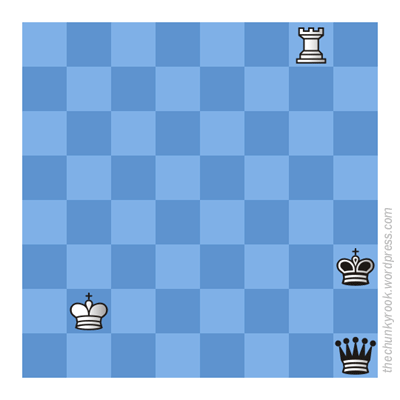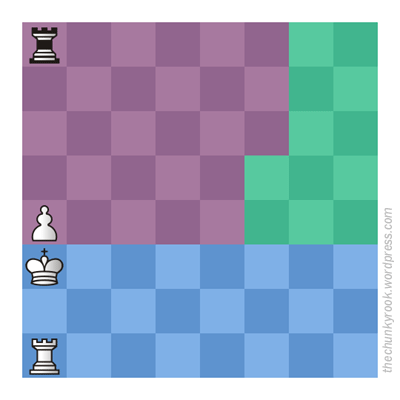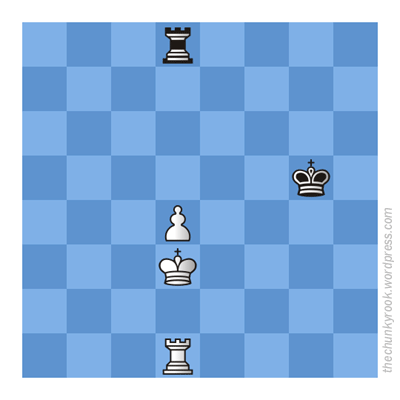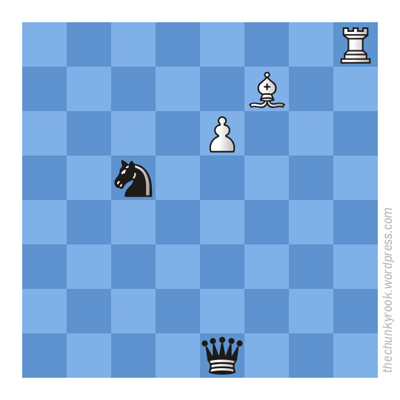King versus Knight Checks
Opposite-Colour Bishop Ending and Some Notes on Memorisation
July 7, 2011
The following gif exemplifies a basic drawing idea in opposite-colour bishop endings: Black wants to

While we’re at it, here’s a previous chunk on opposite colour bishops that illustrates more or less the same idea; White’s in control of the pawn-advance square and keeps the Black king occupied with the defence of the pawn on c4. The resulting position is once again a draw:

On another note: for those of you interested in memorisation, here’s a compelling article on the “spacing effect” and Polish memory specialist Peter Wozniak by Gary Wolf. One of the insights proffered by Wozniak, backed up by what appears to be sorely neglected research into memorisation, is the following:
- control the square of the pawn advance
- attack pawns so that the enemy king is tied down to their defence.

While we’re at it, here’s a previous chunk on opposite colour bishops that illustrates more or less the same idea; White’s in control of the pawn-advance square and keeps the Black king occupied with the defence of the pawn on c4. The resulting position is once again a draw:

On another note: for those of you interested in memorisation, here’s a compelling article on the “spacing effect” and Polish memory specialist Peter Wozniak by Gary Wolf. One of the insights proffered by Wozniak, backed up by what appears to be sorely neglected research into memorisation, is the following:
Once we drop the excuse that memorization is pointless, we’re left with an interesting mystery. Much of the information does remain in our memory, though we cannot recall it. “To this day,” Bjork says, “most people think about forgetting as decay, that memories are like footprints in the sand that gradually fade away. But that has been disproved by a lot of research. The memory appears to be gone because you can’t recall it, but we can prove that it’s still there. For instance, you can still recognize a ‘forgotten’ item in a group. Yes, without continued use, things become inaccessible. But they are not gone.” [...]
Long-term memory, the Bjorks said, can be characterized by two components, which they named retrieval strength and storage strength. Retrieval strength measures how likely you are to recall something right now, how close it is to the surface of your mind. Storage strength measures how deeply the memory is rooted. Some memories may have high storage strength but low retrieval strength. [...] Perhaps you’ve recently been told the names of the children of a new acquaintance. At this moment they may be easily accessible, but they are likely to be utterly forgotten in a few days, and a single repetition a month from now won’t do much to strengthen them at all.
[...] One of the problems is that the amount of storage strength you gain from practice is inversely correlated with the current retrieval strength. In other words, the harder you have to work to get the right answer, the more the answer is sealed in memory. Precisely those things that seem to signal we’re learning well — easy performance on drills, fluency during a lesson, even the subjective feeling that we know something — are misleading when it comes to predicting whether we will remember it in the future. “The most motivated and innovative teachers, to the extent they take current performance as their guide, are going to do the wrong things,” Robert Bjork says. “It’s almost sinister.”
The most popular learning systems sold today — for instance, foreign language software like Rosetta Stone — cheerfully defy every one of the psychologists’ warnings. With its constant feedback and easily accessible clues, Rosetta Stone brilliantly creates a sensation of progress. “Go to Amazon and look at the reviews,” says Greg Keim, Rosetta Stone’s CTO, when I ask him what evidence he has that people are really remembering what they learn. “That is as objective as you can get in terms of a user’s sense of achievement.” The sole problem here, from the psychologists’ perspective, is that the user’s sense of achievement is exactly what we should most distrust.
The spacing effect was one of the proudest lab-derived discoveries, and it was interesting precisely because it was not obvious, even to professional teachers. The same year that Neisser revolted, Robert Bjork, working with Thomas Landauer of Bell Labs, published the results of two experiments involving nearly 700 undergraduate students. Landauer and Bjork were looking for the optimal moment to rehearse something so that it would later be remembered. Their results were impressive: The best time to study something is at the moment you are about to forget it. And yet — as Neisser might have predicted — that insight was useless in the real world. Determining the precise moment of forgetting is essentially impossible in day-to-day life.
 Leave a Comment » |
Leave a Comment » |  endgame, varia | Tagged: bishops of opposite colour, endgame, memory |
endgame, varia | Tagged: bishops of opposite colour, endgame, memory |  Permalink
Permalink Posted by chunkyrook
Posted by chunkyrookPassed Pawn Chunks
June 26, 2011
A shoutout to the Dutch steps method, an excellent self-study course developed by Rob Brunia and Cor van Wijgerden. I’m currently working on the chapter “passed pawns” and thought — to learn as well as advertise — I’d share two chunks from the chapter so far:
Two passed pawns: interrupt one of two defenders.

Setting up a discovered promotion:

Two passed pawns: interrupt one of two defenders.

Setting up a discovered promotion:

 Leave a Comment » |
Leave a Comment » |  endgame | Tagged: discovery, endgame,interference, passed pawn |
endgame | Tagged: discovery, endgame,interference, passed pawn |  Permalink
Permalink Posted by chunkyrook
Posted by chunkyrookGood Philidor and Bad Philidor
July 11, 2010
For some reason, this just popped into my head. Anyway! Another shout-out to Jeremy Silman’s Complete Endgame Course. Today’s topic: good Philidor and bad Philodor. The Philidor position is a key position in rook versus rook and pawn endgames. If the defender is able to reach a Philidor position, he can hold the draw. The good Philidor is a very easy draw if you know the move. The bad Philidor is slightly more complex.
 In the good Philidor, the defender simply occupies the 6th rank. If either White’s king or pawn advances, the defending rook moves to the 1st rank where it has an easy time keeing pawn and king in … wait for it… check. (I admit I have a soft spot for atrocious puns. I probably have used this one before, but I just couldn’t resist.) If king and pawn stay put, the defending rook simply stays on the 6th rank.
In the good Philidor, the defender simply occupies the 6th rank. If either White’s king or pawn advances, the defending rook moves to the 1st rank where it has an easy time keeing pawn and king in … wait for it… check. (I admit I have a soft spot for atrocious puns. I probably have used this one before, but I just couldn’t resist.) If king and pawn stay put, the defending rook simply stays on the 6th rank.

In the bad Philidor, White gets to the 6th rank first, so Black has to come up with a different plan. This time, he uses the principles of “short side of the pawn” and “checking distance” by situating his rook behind the pawn and using his king to add an additional defender to the square in front of it, denying White any chance of making progress that way. If White tries to push the king away from the defence of the square, Black uses his long checking distance on the long side of the pawn to threaten infinite checks or a pawn capture by the rook.

 In the good Philidor, the defender simply occupies the 6th rank. If either White’s king or pawn advances, the defending rook moves to the 1st rank where it has an easy time keeing pawn and king in … wait for it… check. (I admit I have a soft spot for atrocious puns. I probably have used this one before, but I just couldn’t resist.) If king and pawn stay put, the defending rook simply stays on the 6th rank.
In the good Philidor, the defender simply occupies the 6th rank. If either White’s king or pawn advances, the defending rook moves to the 1st rank where it has an easy time keeing pawn and king in … wait for it… check. (I admit I have a soft spot for atrocious puns. I probably have used this one before, but I just couldn’t resist.) If king and pawn stay put, the defending rook simply stays on the 6th rank.
In the bad Philidor, White gets to the 6th rank first, so Black has to come up with a different plan. This time, he uses the principles of “short side of the pawn” and “checking distance” by situating his rook behind the pawn and using his king to add an additional defender to the square in front of it, denying White any chance of making progress that way. If White tries to push the king away from the defence of the square, Black uses his long checking distance on the long side of the pawn to threaten infinite checks or a pawn capture by the rook.

 Leave a Comment » |
Leave a Comment » |  endgame | Tagged: endgame, philidor position,rook versus rook and pawn |
endgame | Tagged: endgame, philidor position,rook versus rook and pawn |  Permalink
Permalink Posted by chunkyrook
Posted by chunkyrookSome Resources in Rook Endgames
June 23, 2010
I’ve been reviewing the A-section of my one and only endgame book,Silman’s Complete Endgame Course, in particular rook versus rook and pawn on the 4th/5th rank. A couple of months ago, I made some gifs showing the abstract rules of such endgames. This time, I’ve added some more concrete ideas. Here you go:
Pawn on the 5th in the abstract: if the Black king is in the red zone, it’s a draw.

Pawn on the 4th in the abstract: if the Black king is in the red zone, it’s a draw.

So let’s get more concrete! Use your king to defend intrusion squares:

If you are defending, you want your king on the short side of the board and your rook on the long side of the board because of the checking distance:

If defending on the short side, return to attack the pawn to force the king to defend:

Once again: defend intrusion squares with your king.

White’s goal is to escape those checks and advance the pawn; seeking refuge from checks behind his rook is one last resource to achieve that:

Unfortunately in this case, it’s a draw: Black can exchange rooks and gain the opposition. Whenever you offer a rook exchange, you should ask yourself: What happens in terms of opposition? (The other big question is: does the exchange lead to a stalemate?)

Cutting off the enemy king along a rank rather than a file is sometimes the key to victory!

… which is why, once again, Black’s king has to defend the intrusion squares:
 To sum up some of the key ideas in rook versus rook and pawn endgames:
To sum up some of the key ideas in rook versus rook and pawn endgames:
Pawn on the 5th in the abstract: if the Black king is in the red zone, it’s a draw.

Pawn on the 4th in the abstract: if the Black king is in the red zone, it’s a draw.

So let’s get more concrete! Use your king to defend intrusion squares:

If you are defending, you want your king on the short side of the board and your rook on the long side of the board because of the checking distance:

If defending on the short side, return to attack the pawn to force the king to defend:

Once again: defend intrusion squares with your king.

White’s goal is to escape those checks and advance the pawn; seeking refuge from checks behind his rook is one last resource to achieve that:

Unfortunately in this case, it’s a draw: Black can exchange rooks and gain the opposition. Whenever you offer a rook exchange, you should ask yourself: What happens in terms of opposition? (The other big question is: does the exchange lead to a stalemate?)

Cutting off the enemy king along a rank rather than a file is sometimes the key to victory!

… which is why, once again, Black’s king has to defend the intrusion squares:
 To sum up some of the key ideas in rook versus rook and pawn endgames:
To sum up some of the key ideas in rook versus rook and pawn endgames:- opposition
- cutting off the king
- intrusion squares
- refuge from checks
- long side of the board / short side of the board
- checking distance
 Leave a Comment » |
Leave a Comment » |  endgame | Tagged: endgame, pawn on the 4th rank, pawn on the 5th rank, rook endgame |
endgame | Tagged: endgame, pawn on the 4th rank, pawn on the 5th rank, rook endgame |  Permalink
Permalink Posted by chunkyrook
Posted by chunkyrookAdvance the Candidate!
April 6, 2010Endgame Narrative: How to Pick Up a Rook with a Queen
November 16, 2009
Queen and king versus king and rook endgames are a bitch to play when the king is close to his precious rook. The amount of tactical moments that have to be heeded are so vast that construing an endgame narrative seems nigh impossible. So for the time being, I’ve abandoned the quest to master that endgame, and will tell you the story of its little cousin instead, the very easy and simple queen and king versus king and rook endgame when the king is far away from his precious rook. Are you ready? Once upon a time, a queen checked a king…
 This technique may come in handy in several endgames: check outSacrifice for Check and Winning the Lucena with a Rook Pawn.
This technique may come in handy in several endgames: check outSacrifice for Check and Winning the Lucena with a Rook Pawn.
 This technique may come in handy in several endgames: check outSacrifice for Check and Winning the Lucena with a Rook Pawn.
This technique may come in handy in several endgames: check outSacrifice for Check and Winning the Lucena with a Rook Pawn. Leave a Comment » |
Leave a Comment » |  endgame | Tagged: endgame, endgame narrative, queen versus rook |
endgame | Tagged: endgame, endgame narrative, queen versus rook |  Permalink
Permalink Posted by chunkyrook
Posted by chunkyrookEndgame Narrative: Rook versus Rook and Pawn on the Fourth
November 15, 2009
In my ACIS improvement plan, I mentioned “memorising certain endgame positions with the help of gifs”. Endgames, like everything in chess really, are about knowledge and technique. On the one hand, it’s helpful to know that you can checkmate with a rook against a king, but not with a bishop against a king. It makes your life easier to know that bishops of opposite colour tend to be drawish, or that a queen against a single pawn isn’t always a win. That’s endgame knowledge. Then there’s technique: the actual skill of executing a mating attack with a rook against a lone king; how to achieve a draw with bishops of opposite colours; how to prevent the pawn from queening if you have a queen versus a lone king and pawn, or how to draw if you’re on the side with the pawn. Etc. etc.
I’ve recently posted two endgame knowledge gifs: rook vs rook and pawn on the 4th rank, and rook vs rook and pawn on the 5th rank. I consider those semi-useful. Maybe they’re not that useful, but it’s kinda cool to know such things by heart. And I included some hints as to the technique of how to play those endings. However, those comments are a far cry from actually mastering this type of endgame. Therefore, I need to study and practise the technique involved. The first step towards mastering the technique, I believe, is an endgame narrative. Just as chess is a narrative that progresses from opening to middlegame to endgame, the endgames themselves are narratives. For instance, mating with a rook: you progress from trapping the enemy king in a box with your rook, closing in with your king, and making the box smaller and smaller until mate. Of course, you’ll still have to calculate precisely and be watchful at every step that your narrative doesn’t deceive you. Nonetheless, narratives are extremely useful because they give you at least a hunch as to what kind of moves to look out for.
Therefore, I intend to post gifs of endgame narratives. I shall replay a certain endgame with the help of the Nalimov Tablebase, try to understand with my patzer instincts the essential technique and based on that add a running commentary to the gif. Of course such a narrative cuts out crucial details and ignores important variations, but it should give me at least a general idea as to what type of move sequences are involved in such an endgame. It remains to be seen whether absorbing such a narrative does more harm than good.
So here’s some endgame knowledge (if the Black king is on a red square, it’s a draw, otherwise it’s a win):
 And here’s the corresponding endgame narrative:
And here’s the corresponding endgame narrative:

I’ve recently posted two endgame knowledge gifs: rook vs rook and pawn on the 4th rank, and rook vs rook and pawn on the 5th rank. I consider those semi-useful. Maybe they’re not that useful, but it’s kinda cool to know such things by heart. And I included some hints as to the technique of how to play those endings. However, those comments are a far cry from actually mastering this type of endgame. Therefore, I need to study and practise the technique involved. The first step towards mastering the technique, I believe, is an endgame narrative. Just as chess is a narrative that progresses from opening to middlegame to endgame, the endgames themselves are narratives. For instance, mating with a rook: you progress from trapping the enemy king in a box with your rook, closing in with your king, and making the box smaller and smaller until mate. Of course, you’ll still have to calculate precisely and be watchful at every step that your narrative doesn’t deceive you. Nonetheless, narratives are extremely useful because they give you at least a hunch as to what kind of moves to look out for.
Therefore, I intend to post gifs of endgame narratives. I shall replay a certain endgame with the help of the Nalimov Tablebase, try to understand with my patzer instincts the essential technique and based on that add a running commentary to the gif. Of course such a narrative cuts out crucial details and ignores important variations, but it should give me at least a general idea as to what type of move sequences are involved in such an endgame. It remains to be seen whether absorbing such a narrative does more harm than good.
So here’s some endgame knowledge (if the Black king is on a red square, it’s a draw, otherwise it’s a win):
 And here’s the corresponding endgame narrative:
And here’s the corresponding endgame narrative:
 2 Comments |
2 Comments |  endgame | Tagged: endgame, endgame narrative,rook versus pawn on the 4th |
endgame | Tagged: endgame, endgame narrative,rook versus pawn on the 4th |  Permalink
Permalink Posted by chunkyrook
Posted by chunkyrookRook Pins Following Captures
October 23, 2009
I have this annoying tendency to overlook rook pins following captures, arguably one of the most common tactical motifs in chess, especially in minor piece+rook endgames. Yesterday, for example, I wasted at least 10 minutes of precious calculation time gauging a variation emerging from knight takes pawn, bishop takes knight, queen takes bishop (as seen in the gif), only to realize that the variation is a no-go due to the in-between move Re1. Even though this is a very basic and straight-forward pattern, certain subtleties are to be heeded, in particular: (A) can your queen or rook move out of the pin and counter-attack a hanging enemy piece? (B) if we’re dealing with a rook vs rook pin, can the pinned piece move away and protect your rook at the same time? If our rook is on a black square, for example, a pinned black-square bishop can move out of the pin and move to a square from which it protects your rook, rendering the pin harmless.
Even though this is a very basic and straight-forward pattern, certain subtleties are to be heeded, in particular: (A) can your queen or rook move out of the pin and counter-attack a hanging enemy piece? (B) if we’re dealing with a rook vs rook pin, can the pinned piece move away and protect your rook at the same time? If our rook is on a black square, for example, a pinned black-square bishop can move out of the pin and move to a square from which it protects your rook, rendering the pin harmless.
 Even though this is a very basic and straight-forward pattern, certain subtleties are to be heeded, in particular: (A) can your queen or rook move out of the pin and counter-attack a hanging enemy piece? (B) if we’re dealing with a rook vs rook pin, can the pinned piece move away and protect your rook at the same time? If our rook is on a black square, for example, a pinned black-square bishop can move out of the pin and move to a square from which it protects your rook, rendering the pin harmless.
Even though this is a very basic and straight-forward pattern, certain subtleties are to be heeded, in particular: (A) can your queen or rook move out of the pin and counter-attack a hanging enemy piece? (B) if we’re dealing with a rook vs rook pin, can the pinned piece move away and protect your rook at the same time? If our rook is on a black square, for example, a pinned black-square bishop can move out of the pin and move to a square from which it protects your rook, rendering the pin harmless. Leave a Comment » |
Leave a Comment » |  endgame, middlegame | Tagged: endgame,middlegame, rook pin |
endgame, middlegame | Tagged: endgame,middlegame, rook pin |  Permalink
Permalink Posted by chunkyrook
Posted by chunkyrookRook vs Rook and Pawn on the 5th rank
October 21, 2009
Complementing the previous post: Once again, White to move, red squares signify Black king positions that lead to a draw with perfect play, green squares signify a Black king position leading to a win for White to move with perfect play. And once again, White’s standard plan is to cut the enemy king off with his rook. However, in some cases, for instance the first green file for rook pawns or the odd green square that’s very close to the pawn, White needs a king move or a check to win. So don’t move your rook heedlessly, thinking that cutting off the enemy king wins automatically.


 Leave a Comment » |
Leave a Comment » |  endgame | Tagged: endgame, pawn on the 5th,rook versus rook and pawn |
endgame | Tagged: endgame, pawn on the 5th,rook versus rook and pawn |  Permalink
Permalink Posted by chunkyrook
Posted by chunkyrook

